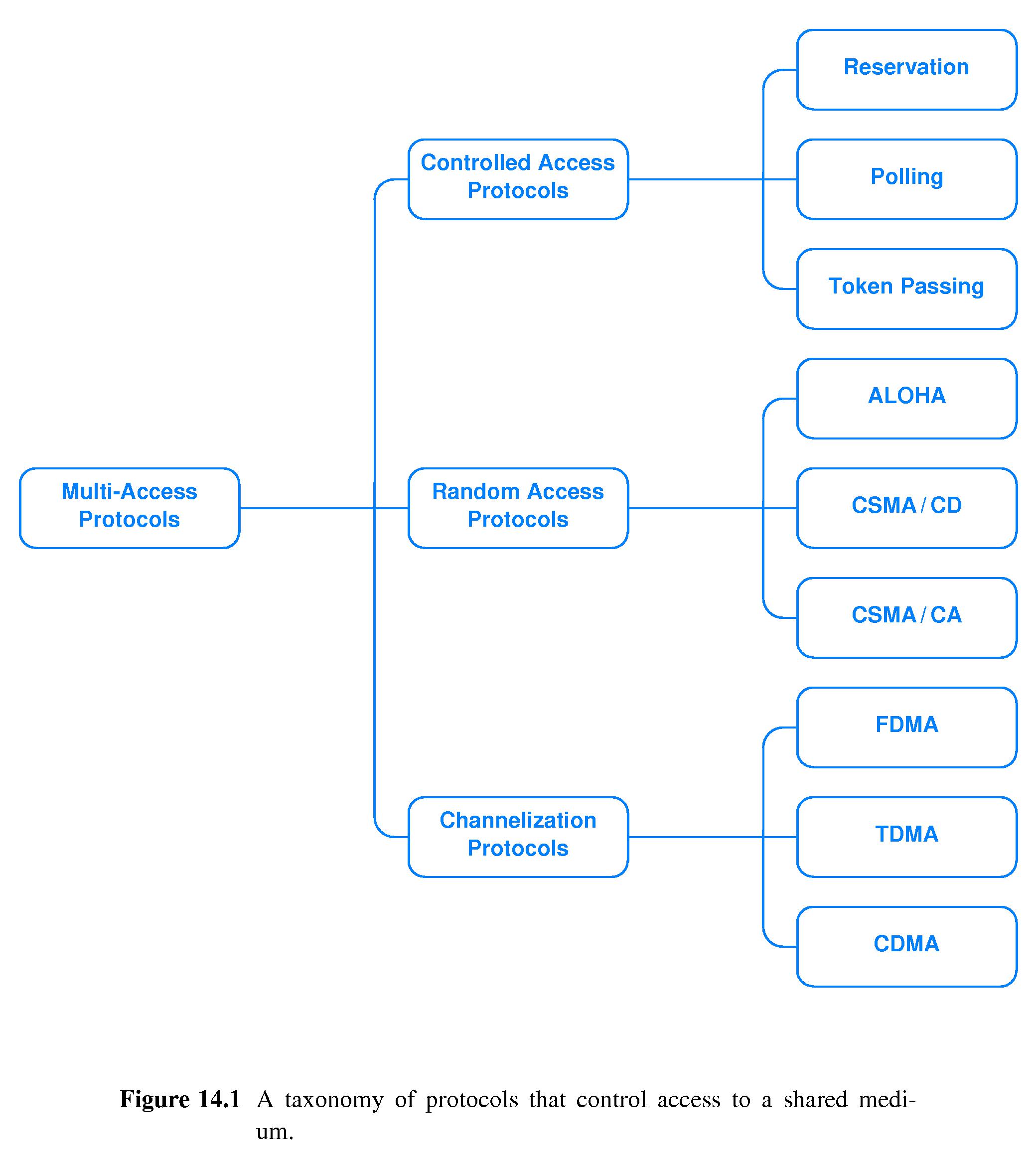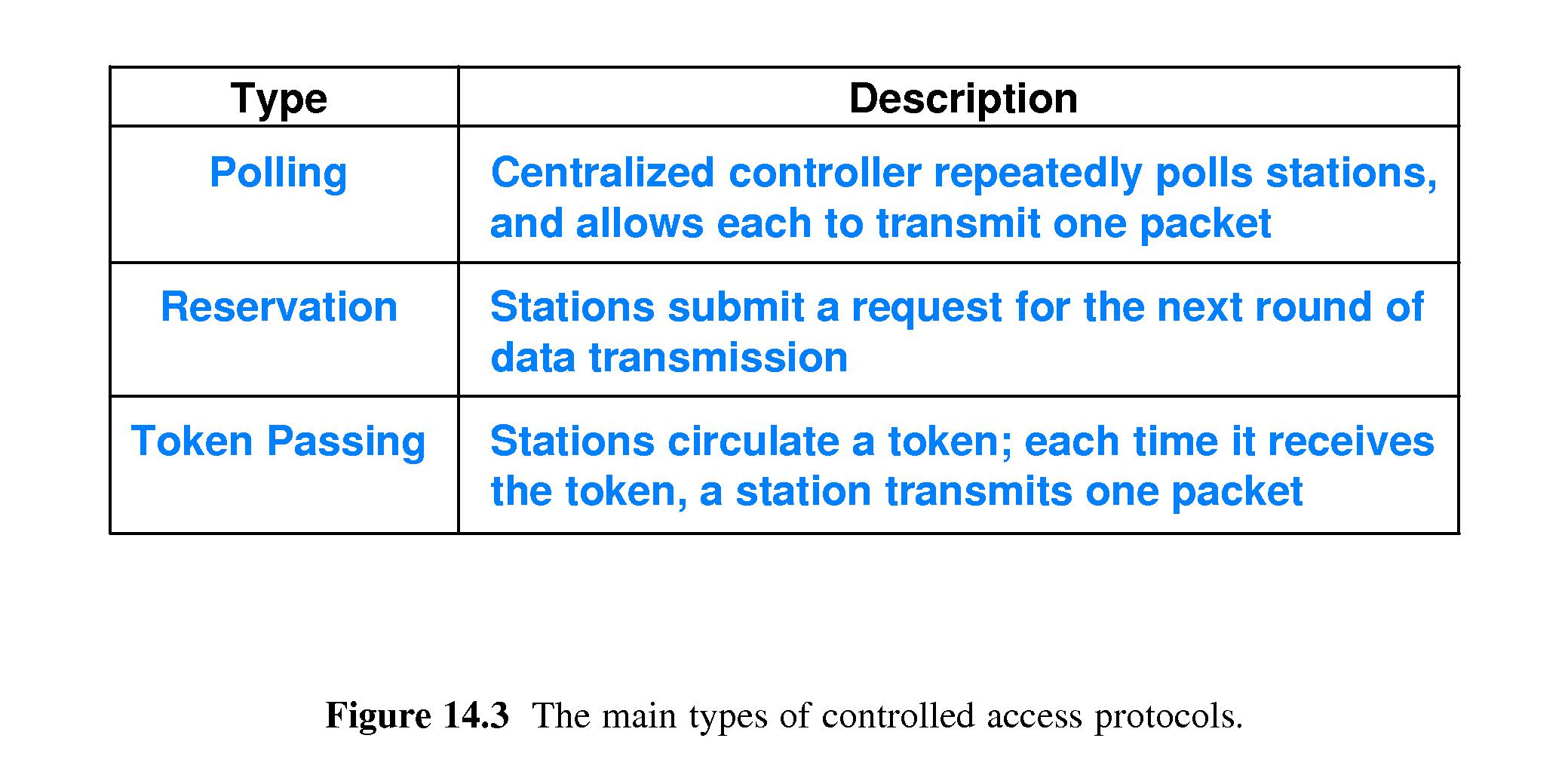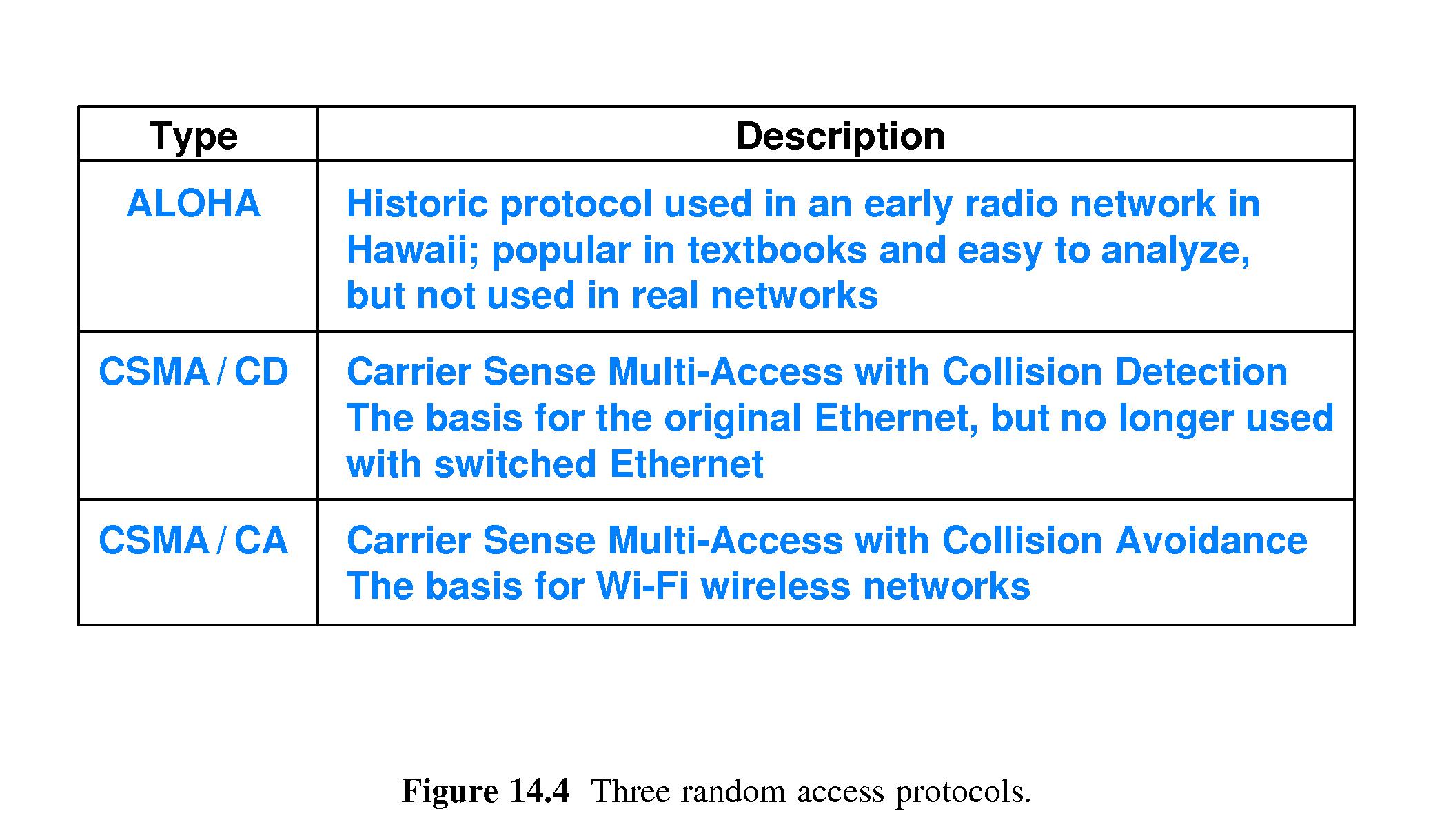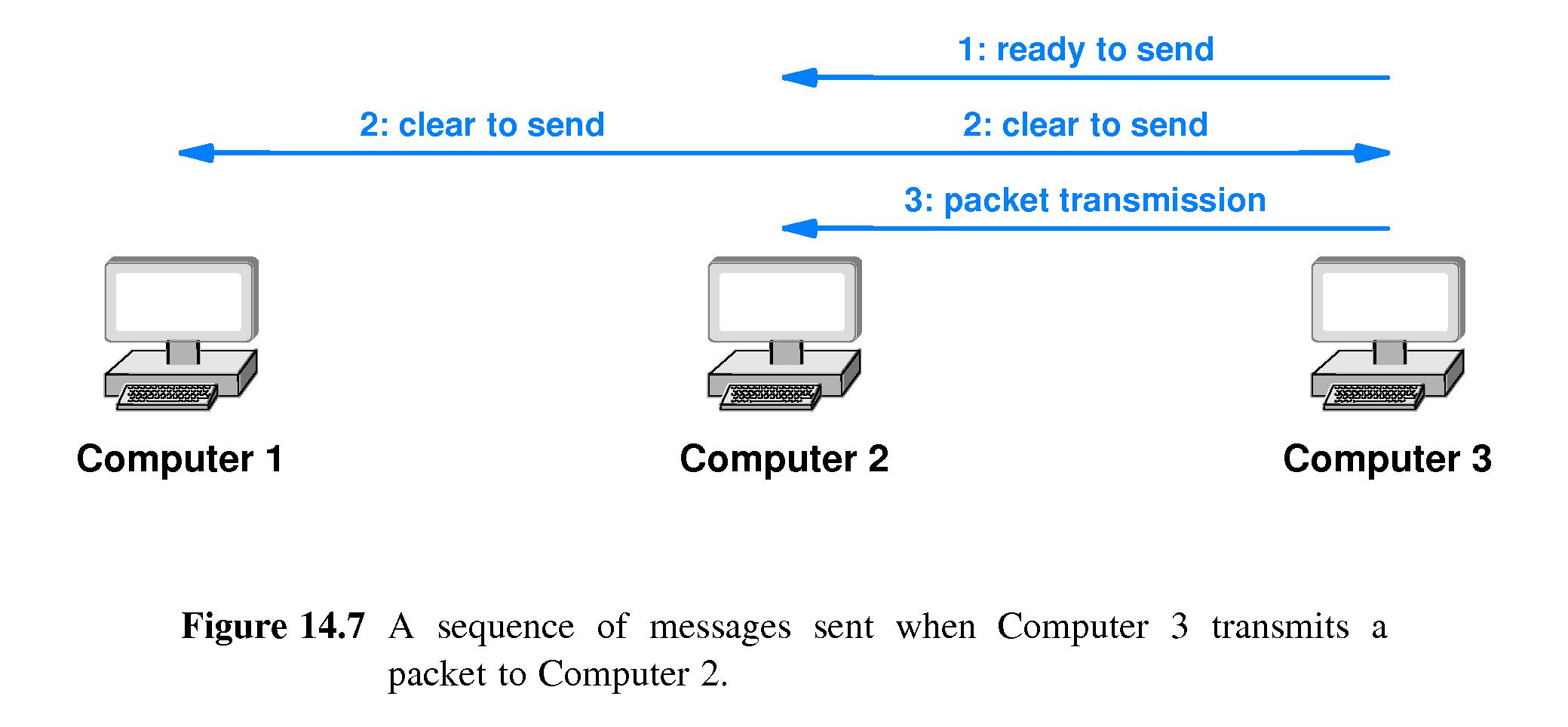(rev. Mar 13, 2017)
Notes On Chapter Fourteen
-- The IEEE MAC Sub-Layer
- 14.0 Study Guide
- Know the basics of how these controlled access protocols work:
polling, reservation, and token passing.
- Understand the basics of how ALOHA, CSMA/CD, and CSMA/CA work.
- 14.1 Introduction
- IEEE MAC sublayer
- Multi-access Protocols
- Static and Dynamic Channel Allocation
- 14.2 A Taxonomy of Mechanisms
for Multi-Access
- Three approaches by which computers can coordinate access to a shared
medium are:
- Controlled Access Protocols - for example:
- Reservation
- Polling
- Token Passing
- Random Access Protocols - for example:
- Channelization Protocols - for example:

- 14.3 Static and Dynamic
Channel Allocation
- An FDM system can assign a channel for the exclusive use of a
communicating pair of computers.
- In some cases a static assignment will suffice.
- In many cases the pairs communicating will vary over time, so
channels need to be allocated and deallocated dynamically.
- 14.4 Channelization Protocols

- Examples:
- FDMA - Frequency Division Multi-Access - for example:
- 'New station' uses reserved control channel to make a
request to a 'central controller'
- Central controller chooses an unused channel and
assigns it to the station
- TDMA - Time Division Multi-Access - for example:
- A station is assigned a time slot during which it is
allowed to send
- This could be a round-robin scheme -- so, for example,
the station might be allowed to send every 3rd packet among
a set of 25 stations.
- CDMA - Code Division Multi-Access
- All senders may send at the same time - they
send "mutually orthogonal" data which is multiplexed by
summing. This is comparable to interleaving at the bit
level.
- 14.5 Controlled Access Protocols

- 14.5.1 Polling
- Centralized controller polls 'stations',giving them an
opportunity to send one packet
- selection may be simple round robin or some priority scheme.
- the controller sends a polling message to a station and the
station responds, either by sending a packet, or 'passing'.
- 14.5.2 Reservation
- Stations send messages in rounds.
- Typically for a period of time, stations send
messages to a central controller saying whether they will
have a need to send a message in the next round.
- Then the controller transmits a list of stations that will be
transmitting in the next round.
- Stations then use the list to determine when to send during the
next round.
- Variation: there is a separate channel for controller to use to
gather reservations.
- This technique is often used with satellite transmission.
- 14.5.3 Token Passing
- There is a special control message called the token.
- The token is passed from station to station according to some
preassigned 'circular order'.
- When a station has the token, it is allowed to transmit a
message.
- The station passes the token immediately, or right after sending
its message.
- 14.6 Random Access Protocols

- 14.6.1 ALOHA
- A protocol used in an early data network in Hawaii.
- The medium was radio frequency
- ALOHA pioneered 'random access techniques'
- A central station with a powerful transmitter is
surrounded by outlying stations with weaker transmitters.
- Transmissions of the central station can reach all outlying
stations, and transmissions of all outlying stations can reach
the central station.
- Transmissions of most outlying stations can't reach all
the other outlying stations.
- The network employs two different frequencies - an
outbound frequency for the central station to send messages to
outlying stations, and an inbound frequency for outlying
stations to send messages to the central station.
- An outlying station that wants to send a packet to another
outlying station transmits the packet to the central station
on the inbound frequency. The central station then
resends the packet on the outbound frequency. Both the intended
receiver and the sender get a copy of the packet sent by the
central station. The copy that is received by the original
sender serves as an acknowledgment that the packet arrived safely.
- Two outlying stations might send a packet at the same time.
If so they interfere with each other (collide),
are unintelligible to the central station, and are NOT
resent by the central station on the outbound frequency.
- If an outlying station sends a packet, and does not soon
receive a copy of the packet back on the outbound frequency,
then the outlying station will retransmit the packet,
after a random delay.
- Because retransmission delays are randomly chosen, there is a
low probability that the two senders that collided before will
collide again.
- If the network is heavily utilized collisions can happen
frequently despite these measures.
- 14.6.2 CSMA/CD - Carrier Sense Multi-Access
with Collision Detection
- The original Ethernet (named after
the luminiferous ether once
theorized to be a medium that made the propagation of light
possible) employs a single long cable (the ether) onto which all
computers connect and transmit.
- Ethernet Carrier Sense Multi-Access with Collision Detection
(CSMA/CD) is similar to ALOHA but utilizes several innovations:
- The "two-frequency idea" was dropped.
- An NIC "carrier senses" and refrains from attempting to send
while a transmission is in progress (this improves
utilization).
- Stations monitor the ether (the shared cable) while
sending, and abort transmission if a collision is detected.
- After detecting a collision, an NIC utilizes a binary
exponential back-off strategy:
- wait a random time (bounded by some constant d) and
attempt to retransmit. [d is the max time it would
take for a frame to travel from one host to another
on the shared medium. The value of d is
about 50 μs for 10 Mbs
Ethernet, and about 5 μs for 100Mbs or 1Gbs
Ethernets.]
- If a second collision occurs, abort again and pick
another random delay, this time bounded by 2d.
- If collisions keep recurring while trying to send the
same packet, keep doubling the maximum delay until
success (or after trying some large number of times,
give up.)
- 14.6.3 CSMA/CA - Carrier Sense Multi-Access
with Collision Avoidance
- One of the things that allows CSMA/CD to work on an Ethernet
is the fact that all NIC's are able to receive each other's
transmissions.
- This is not true in the typical wireless LAN.

- C1 --------- C2 ------------ C3
Suppose (C1,C2) and (C2,C3) are in range, but (C1,C3) are not.
Suppose further that C1 and C3 send at the same time, intending
that C2 be the receiver. The packets will collide at C2, but
the collision will not be detected by C1 or C3.
- There is an alternative called Carrier Sense Multiple Access
with Collision Avoidance.

- When C3 wants to send to C2 it sends a very brief message
announcing that fact.
- Upon receiving that message C2 sends out a brief message saying
it is about to receive a packet from C3.
- Every computer within range of either C3 or C2 receives one or
both of these short messages, and refrains from sending for a
long enough time so that C3 can send its packet to C2 without
interference.
- If a control message from C3 collides at C2 with a control
message from C1, then much like with ALOHA, C2 will NOT reply
and C1 and C3 will apply a random backoff scheme until one of
them succeeds in getting a control message through to C2.





